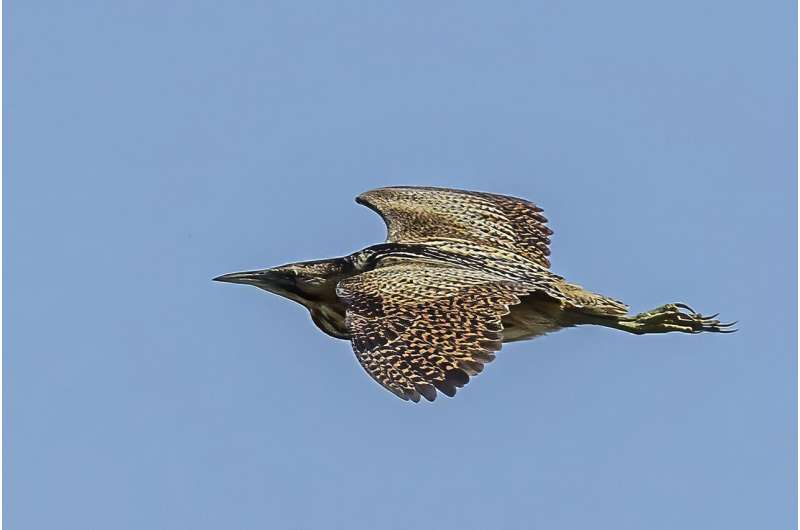This article has been reviewed according to Science X's editorial process and policies. Editors have highlighted the following attributes while ensuring the content's credibility:
fact-checked
trusted source
written by researcher(s)
proofread
Why Britain's loudest bird is booming after decades of decline

The Eurasian bittern (Botaurus stellaris) is a reclusive bird belonging to the heron family. Close to the size of a chicken, bitterns are a mix of golden-brown mottled with delicate black and tan. With long, green legs and large feet, these birds are adapted for skulking through reedbeds—the bits of wetland covered by dense patches of common reed—to quietly hunt fish and amphibians.
Often invisible, their presence in freshwater marshes is given away by a low-pitched booming note that can be heard at great distances—especially in early spring, as males set up and defend territories. The call is an eerie noise if you are lucky enough to hear it. In the past it provoked superstition and even fear of bitterns, their call being thought to portend some impending doom. Thankfully, times and attitudes to bitterns have changed.
The bittern was once common in wetlands across the UK but it was lost as a breeding bird in the 1870s. With a big push from far-sighted conservationists it has enjoyed a remarkable comeback. The latest counts by the RSPB and Natural England clocked up 228 calling males at 103 sites nationwide in 2022.
The recovery of the bittern is a textbook example of how to conserve a species. My team has been closely involved in the research and, more recently, in the monitoring of this species.
Over half of the UK's bitterns are found on RSPB reserves where rangers diligently manage and nurture reedbeds. This also attracts other wetland birds like cranes and egrets, as well as rare mammals, fishes, invertebrates and plants. As bittern numbers have risen, they have spread their wings and spread out. In 2022, they bred for the first time at RSPB Saltholme Nature Reserve in Teesside—their most northerly breeding record in recent history.
Bringing bitterns back
The bittern's story is one of boom and bust. Their demise in the 1880s was driven by widespread land drainage as extensive bogs, marshes and reedbeds made way for farmland, a process that took off a century earlier. At this time they were also hunted for the dinner table and pursued by skin and egg collectors.
Somewhat against the odds, bitterns returned under their own steam as breeding birds from 1900. Their numbers grew steadily to reach a peak in 1954, with some 80 booming males found mostly in the Norfolk Broads. It seems the increase was helped by the flooding and abandonment of low-lying coastal land during World War II to defend against a German invasion. This allowed reeds and bitterns to return. Even so, having most birds concentrated in just one area was always risky.
From that peak, bittern numbers tumbled and by 1997 there were just seven sites with 11 calling males. The situation was dire, and so conservationists gathered to devise a plan to save the species.
Their audacious target was to have 100 booming birds by 2020. Central to their scheme was a research program concerned with understanding the habitat requirements of these birds and what food was available at the main sites they frequented. At that point, this information was largely unknown.
It quickly became apparent that the downturn from the 1950s reflected the poor state of their favored wetlands, as many were drying out and becoming overgrown. Pioneering research combined what were then new technologies, like radio-tagging and sonogram identification of males by call, with nest findings, electro-fishing and habitat recording, to better understand what made bitterns tick.
Put simply, and unsurprisingly perhaps, they need large wetlands, a wet marshland and lots of fish.
Research shows they prefer large, marshy habitats with gently sloping water edges and plenty of variation. They need deep water, especially during spring as the breeding season approaches, and they like a mix of interconnected open pools and dense reeds with abundant aquatic plants and high water quality to support the fish they eat (rudd and eel are favorites) in summer and winter.
Armed with that recipe, wetland restoration and creation kicked off in earnest in the mid-1990s.
The plan to revive Britain's bitterns was bold: they needed better, bigger and more places to live. We also needed to encourage birds away from their eastern haunts, as many of those coastal habitats are threatened by sea-level rise. In short, we needed more eggs in more baskets.
This translated into a major effort to rejuvenate and refresh the management of existing and potential sites. But it went further, converting carrot fields and places where minerals and peat were extracted into significant new oases of reedbeds. These are now overflowing with nature and fantastic places for people to visit. Concerted action across over 20 locations has created nearly 3,000 hectares of restored or new habitat for bitterns, and more are planned.
This wouldn't have happened without the hard work of visionary conservationists and some great partner organizations. Crucially, from the 1990s the RSPB and Natural England have kept tabs on the number of bitterns and that has been vital for understanding the plan's performance.
The 2020 target for 100 booming birds has been met more than twice over, and we are confident that bittern numbers will nudge further upwards if conservationists stick with the plan.
Provided by The Conversation
This article is republished from The Conversation under a Creative Commons license. Read the original article.![]()



















